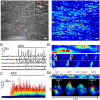Small-world connectivity dictates collective endothelial cell signaling
- PMID: 35482920
- PMCID: PMC9170162
- DOI: 10.1073/pnas.2118927119
Small-world connectivity dictates collective endothelial cell signaling
Abstract
Every blood vessel is lined by a single layer of highly specialized, yet adaptable and multifunctional endothelial cells. These cells, the endothelium, control vascular contractility, hemostasis, and inflammation and regulate the exchange of oxygen, nutrients, and waste products between circulating blood and tissue. To control each function, the endothelium processes endlessly arriving requests from multiple sources using separate clusters of cells specialized to detect specific stimuli. A well-developed but poorly understood communication system operates between cells to integrate multiple lines of information and coordinate endothelial responses. Here, the nature of the communication network has been addressed using single-cell Ca2+ imaging across thousands of endothelial cells in intact blood vessels. Cell activities were cross-correlated and compared to a stochastic model to determine network connections. Highly correlated Ca2+ activities occurred in scattered cell clusters, and network communication links between them exhibited unexpectedly short path lengths. The number of connections between cells (degree distribution) followed a power-law relationship revealing a scale-free network topology. The path length and degree distribution revealed an endothelial network with a “small-world” configuration. The small-world configuration confers particularly dynamic endothelial properties including high signal-propagation speed, stability, and a high degree of synchronizability. Local activation of small clusters of cells revealed that the short path lengths and rapid signal transmission were achieved by shortcuts via connecting extensions to nonlocal cells. These findings reveal that the endothelial network design is effective for local and global efficiency in the interaction of the cells and rapid and robust communication between endothelial cells in order to efficiently control cardiovascular activity.
Keywords: calcium; endothelium; network; signaling; small-world.
Conflict of interest statement
The authors declare no competing interest.
Figures







Similar articles
-
The Endothelium Solves Problems That Endothelial Cells Do Not Know Exist.Trends Pharmacol Sci. 2017 Apr;38(4):322-338. doi: 10.1016/j.tips.2017.01.008. Epub 2017 Feb 16. Trends Pharmacol Sci. 2017. PMID: 28214012 Free PMC article. Review.
-
Disrupted endothelial cell heterogeneity and network organization impair vascular function in prediabetic obesity.Metabolism. 2020 Oct;111:154340. doi: 10.1016/j.metabol.2020.154340. Epub 2020 Aug 11. Metabolism. 2020. PMID: 32791171 Free PMC article.
-
Heterogeneity and emergent behaviour in the vascular endothelium.Curr Opin Pharmacol. 2019 Apr;45:23-32. doi: 10.1016/j.coph.2019.03.008. Epub 2019 Apr 18. Curr Opin Pharmacol. 2019. PMID: 31005824 Free PMC article. Review.
-
Clusters of specialized detector cells provide sensitive and high fidelity receptor signaling in the intact endothelium.FASEB J. 2016 May;30(5):2000-13. doi: 10.1096/fj.201500090. Epub 2016 Feb 12. FASEB J. 2016. PMID: 26873937 Free PMC article.
-
Spatial-temporal order-disorder transition in angiogenic NOTCH signaling controls cell fate specification.Elife. 2024 Feb 20;12:RP89262. doi: 10.7554/eLife.89262. Elife. 2024. PMID: 38376371 Free PMC article.
Cited by
-
Endothelial PAR2 activation evokes resistance artery relaxation.J Cell Physiol. 2023 Apr;238(4):776-789. doi: 10.1002/jcp.30973. Epub 2023 Feb 15. J Cell Physiol. 2023. PMID: 36791026 Free PMC article.
-
Cracking the Endothelial Calcium (Ca2+) Code: A Matter of Timing and Spacing.Int J Mol Sci. 2023 Nov 26;24(23):16765. doi: 10.3390/ijms242316765. Int J Mol Sci. 2023. PMID: 38069089 Free PMC article. Review.
-
Embodied cognitive morphogenesis as a route to intelligent systems.Interface Focus. 2023 Apr 14;13(3):20220067. doi: 10.1098/rsfs.2022.0067. eCollection 2023 Jun 6. Interface Focus. 2023. PMID: 37065267 Free PMC article.
-
Modularity-based mathematical modeling of ligand inter-nanocluster connectivity for unraveling reversible stem cell regulation.Nat Commun. 2024 Dec 23;15(1):10665. doi: 10.1038/s41467-024-54557-8. Nat Commun. 2024. PMID: 39715783 Free PMC article.
-
Pericyte Electrical Signalling and Brain Haemodynamics.Basic Clin Pharmacol Toxicol. 2025 May;136(5):e70030. doi: 10.1111/bcpt.70030. Basic Clin Pharmacol Toxicol. 2025. PMID: 40159653 Free PMC article. Review.
References
-
- Zuccolo E., et al. , Glutamate triggers intracellular Ca2+ oscillations and nitric oxide release by inducing NAADP- and InsP3-dependent Ca2+ release in mouse brain endothelial cells. J. Cell. Physiol. 234, 3538–3554 (2019). - PubMed
-
- Garland C. J., et al. , Voltage-dependent Ca2+ entry into smooth muscle during contraction promotes endothelium-mediated feedback vasodilation in arterioles. Sci. Signal. 10, eaal3806 (2017). - PubMed
Publication types
MeSH terms
Grants and funding
LinkOut - more resources
Full Text Sources
Miscellaneous

